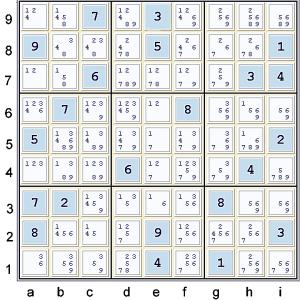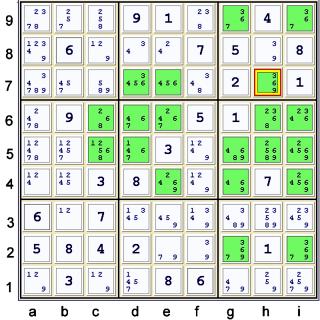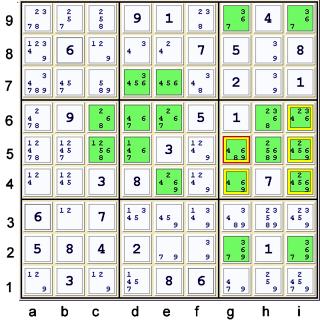The following technique is only a tad more difficult than the first beginner tips. It involves
applying the rules an additional time. This technique is often called Column, Box, Row interactions.
I generally just call this tip Locked Candidates. Without regard to the choice of nomenclature, the
technique is as follows:
If a candidate is already excluded from two of three boxes in any one row,
then that candidate is locked into that row within the remaining box. Therefor, the
candidate can be safely excluded from the other rows within that box.
If a candidate is already excluded from two of three boxes in any one column,
then that candidate is locked into that column within the remaining box. Therefor, the
candidate can be safely excluded from the other columns within that box.
If a candidate exists only in one row within a box, then it is locked into that box with respect
to that row. Therefor, it can safely be excluded from the locations in that row outside of the box.
If a candidate exists only in one column within a box, then it is locked into that box with respect
to that column. Therefor, it can safely be excluded from the locations in that column outside of the box.
After I introduce forbidding chains in this blog, this technique will be the only depth 1
technique. It is represented in a forbidding chain with just one strong link between either two
cells, or two groups of 3 cells.
The Possibility Matrix
Before showing examples of this technique, it is proper to introduce the possibility
matrix . Although many techniques can be utilyzed without considering the possibility matrix,
the possibility matrix is a significant help for all techniques, including even Unique
Possibilities. This is a simple concept. One merely enters all the possible candidates into
each cell. When doing this, one applies the rule of exclusion - that a candidate can appear
only once in a large container (box, column, row). Therefor, if a cell within a large container is
already solved, that solved candidate is not entered as a possibility within any other cells in
that large container. The following is an example of a puzzle with the possible candidates filled in.

Please find below two examples of the locked candidates technique.
Candidates locked into a row, excluded from the rest of the box

In this example, the all the possible locations candidate 6 are highlighted in green. Note:
- In row 9 the sixes are limited to two locations: g9,i9.
- Both of these locations are located within box h8.
- If a six were to occur within box h8 but not at g9 or i9, then row 9 would have no sixes
possible within it.
Therefor, we can safely exclude sixes from all cells within box h8 but not in
the ninth row. In this example, we can eliminate 6 from h7.
To those whom are observant, one can also eliminate that same 6 from h7 considering the 6's
at d7,e7. In this case, the sixes in box e8
are limited to just two locations, both of which are in row 7. Therefor, if a six were to occur outside
of box e8 in row 7, then box e8 would be left with no sixes possible within it.
In both of these cases, I would present this idea in a proof as follows:
- Locked 6's at gi9 forbids h7=6. OR
- Locked 6's at de7 forbids h7=6.
By the way, it is not unusual that the same candidate can be eliminated in more than one way.
Candidates locked into a column within a box, excluded from the rest of the box

This is the same puzzle as the previous example, after eliminating the 6 from h7. Again we are
looking at the sixes, highlighted in green. Note:
- In column h the sixes are limited to two locations:h5 and h6.
- Both h5 and h6 are within box h5.
- If a six were to occur in box h5 outside of column h,
then there would be no possible locations for 6 in column h.
Therefor, we can safely eliminate all the sixes from box h5 in columns g and i.
In this case, we exclude six from g4,g5,i4,i5,and i6.
I would present this idea in a proof as follows:
- Locked 6's at h56 forbids g45,i456=6.
After making these eliminations, note that row 4 will contain only 1 possible location for 6.
Therefor, we can solve cell e4=6. This would be written in a proof as UP##, where ## would be the number
of filled cells one can get using only Unique Possibilities from this point. In this case, it
would be UP 29. The symbol % is used to mean the only place or candidate left.
The next three steps then could be written as
- e4=6%row
- d7=6%row or d7=6%box
- e7=5%box